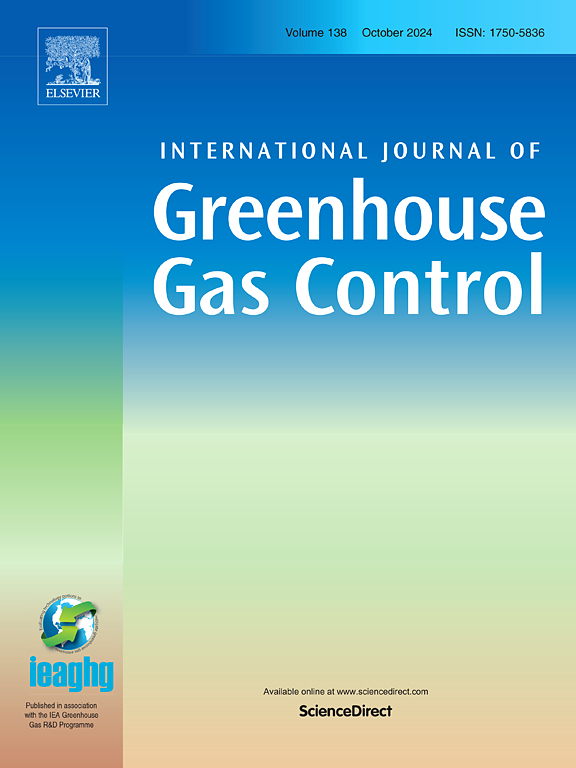地质CO2储存条件下石灰岩实验虫孔地层的三维达西尺度反应输运模型
IF 5.2
3区 工程技术
Q2 ENERGY & FUELS
International Journal of Greenhouse Gas Control
Pub Date : 2025-08-20
DOI:10.1016/j.ijggc.2025.104452
引用次数: 0
摘要
地质二氧化碳储存预计将在缓解气候变化危机中发挥关键作用。碳酸盐岩与CO2作为产酸剂相互作用时,孔隙结构和水力特性可能发生变化。理解和评估这种变化的能力有助于更好地了解二氧化碳在地下的流动和储存行为。在这里,我们将实验室实验和二氧化碳饱和水和HCl溶液注入石灰岩样品的数值模拟相结合,以更好地了解这些岩石中的反应流动。我们采用基于x射线微计算机断层扫描(µCT)的数字岩石方法来构建非均质岩石渗透率图,并将其作为实验的三维达西尺度反应输运模型的输入。模拟令人满意地再现了流出物化学、孔隙度和渗透率的测量变化,以及观察到的反应岩石样品中的溶解特征。研究表明,从注酸开始,孔隙空间非均质性就控制着化学反应,而随着反应锋进一步渗透岩石,酸性类型变得越来越重要。HCl作为强酸的完全解离导致紧凑的溶解模式,使用经典的Kozeny-Carman孔隙度-渗透率关系进行数值捕获。相反,CO2水溶液作为弱酸的部分解离和相关的ph缓冲效应驱动流体流动和溶解之间的强烈反馈,导致虫孔的形成。这种溶解模式只能在孔隙度-渗透率关系中通过大指数(15 ~ 27.6)来再现。所获得的结果强调了渗透性石灰岩中小规模非均质性和酸类型对耦合流动和化学反应的主要控制,以及对现场规模研究的严格升级方法的必要性。本文章由计算机程序翻译,如有差异,请以英文原文为准。
A 3D Darcy-scale reactive transport modeling of experimental wormhole formation in limestone under geological CO2 storage conditions
Geologic CO2 storage is projected to play a key role in mitigating the climate change crisis. Changes in pore structure and hydraulic properties are likely to occur in carbonate rocks when they interact with CO2 as an acid-producing agent. The ability to understand and evaluate such alterations benefits an improved understanding of CO2 flow and storage behavior in the subsurface. Here, we combine laboratory experiments and numerical simulations of CO2-saturated water and HCl solution injections into limestone specimens to develop an improved understanding of reactive flow in these rocks. We employ a digital rock approach based on X-ray micro-computed tomography (µCT) to construct heterogeneous rock permeability maps, fed as inputs into 3D Darcy-scale reactive transport models of the experiments. The simulations satisfactorily reproduce measured changes in effluent chemistry, porosity, and permeability as well as the observed dissolution features in reacted rock samples. We show that the pore space heterogeneity controls chemical reactions from the very beginning of acid injections while the acid type becomes progressively important as the reaction front further penetrates the rock. The complete dissociation of HCl as a strong acid leads to a compact dissolution pattern, numerically captured using the classical Kozeny-Carman porosity-permeability relationship. In contrast, the partial dissociation of aqueous CO2 as a weak acid and the related pH-buffering effect drive a strong feedback between fluid flow and dissolution, leading to wormhole formation. This dissolution pattern can be only reproduced by a large exponent (15 to 27.6) in the porosity-permeability relationship. The obtained results highlight the primary control of small-scale heterogeneities and acid type on coupled flow and chemical reactions in permeable limestones and the need for a rigorous upscaling approach for field-scale studies.
求助全文
通过发布文献求助,成功后即可免费获取论文全文。
去求助
来源期刊
CiteScore
9.20
自引率
10.30%
发文量
199
审稿时长
4.8 months
期刊介绍:
The International Journal of Greenhouse Gas Control is a peer reviewed journal focusing on scientific and engineering developments in greenhouse gas control through capture and storage at large stationary emitters in the power sector and in other major resource, manufacturing and production industries. The Journal covers all greenhouse gas emissions within the power and industrial sectors, and comprises both technical and non-technical related literature in one volume. Original research, review and comments papers are included.

 求助内容:
求助内容: 应助结果提醒方式:
应助结果提醒方式:


